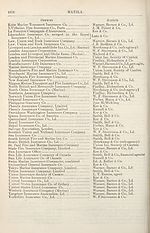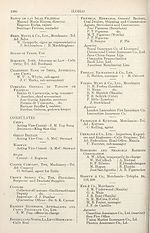1918
(1459) [Page 1379] - Iloilo
Download files
Complete book:
Individual page:
Thumbnail gallery: Grid view | List view
![(1459) [Page 1379] - Iloilo](https://deriv.nls.uk/dcn17/1949/1229/194912299.17.jpg)
ILOILO
This port, which is the chief town of the populous province of the same name in the
island of Panay, is situated in about lat. 11 deg. N., and long. 123 E., near the south-eastern
extremity of the island, close to the sea, on the border of the narrow channel, some three
and a half miles wide, formed by the opposite island of Guimaras. . Iloilo is the largest
town on the island of Panay and is considered the second city of the Philippine
Islands. The harbour is well protected and has good anchorage for steamers of any size.
The river is dredged to 24 ft. low water with a rise of 6 ft., and steamers can now
enter and load full cargoes alongside the wharves. The high ground of Guimaras
forms a kind of funnel with the Panay shore and the result is that a calm is of rare
occurrence, there being almost always a breeze. In the old Spanish days it was one
of the health resorts of the Islands. The population is about 48,000. The better class
houses are built of reinforced concrete, while the poorer classes live in flimsy
structures of cane and nipa. The means of communication are excellent, there being
a station of the Eastern Extension Cable Co., while for communication with the
interior it is possible to communicate over the line operated by the Bureau of Posts to
practically all the towns in Panay, while the Cable Co. have a branch line to Bacolod,
the principal town on the east coast of Negros. As regards shipping there is a
weekly service to and from Manila, which is some 350 miles distant. The town is lit
up by electricity and a telephone system exists.
Iloilo is the centre for the sugar industry which for the most part comes from the
island of Negros, and an average of about 3,000,000 piculs pass through the port each year;
owing to the facilities granted by the United States, whereby it is allowed in free of uuty,
the greater pa.rt of it is shipped there. Bice is grown on a fairly large scale, but
enough is not raised for consumption, and large importations are necessary from
Saigon and Hongkong. There is a weekly service between Hongkong ana Iloilo
via Manila.
On the 23rd December, 1898, the Spanish Governor-General resident in Iloilo
resigned, giving over the care of the town to the Mayor, or Alcalde, of Iloilo, preparing
with his troops and Government officials, naval, military and civil, to evacuate the
place, which on the 25th December was accomplished. On the 26th December,
1898, the town of Iloilo, which for over a month had been entirely surrounded on
the land side by Revolutionary forces, was delivered over to them by the Spanish
Alcalde, and the Philippine Republic flag was hoisted on all the public buildings.
On the 28th December, 1898, the United States forces, composed of the U.S.S.
Baltimore and three transports with 3,800 troops, under the command of Brigadier-
General Miller, arrived in front of Iloilo, but did not land, as the Revolutionary forces
declined to give up the town unless under orders from Aguinaldo, their chief. Affairs in
Luzon having come to an open rupture between the United States and the Revolutionary
forces, the General commanding the United States expedition advised the foreign
Gonsulates that hostilities would commence after 5 a.m. on the 12th February. The
Revolutionary forces set fire to the city, leaving it almost in ruins, and retired outside the
city limits. Iloilo was immediately occupied by the Americans.
DIRECTORY
Province of Iloilo
Governor—Gregorio Yulo
Treasurer R. S. van Valkenburgh
Member, Prov. Bd.—Jose E. Locsin
Member, Prov. Bd.—Modesto Ledesma I
Secretary, Prov. Bd.—Jose Ma Talebn
District Health Officer—Dr. G. J.Cullen
Treasurer—R. S. van Valkcnburgh
Divisions Supt.—C. W. Franks
District Auditor—T. Borromeo
District Engineer—W. C. A. Palmer
Actg. Judge 1st Instance-—Antonio
Villareal
Fiscal Provincial—Conrado Carballo
Senators—Jose Altavas and Francisco
Villanueva
Representatives to the Philippine As¬
sembly—Jose Ma. Arroyo, Grescen-
ciano Lozano, Nicanor Gregorius,
Tiburcio Lutero, and Juan De Leon
This port, which is the chief town of the populous province of the same name in the
island of Panay, is situated in about lat. 11 deg. N., and long. 123 E., near the south-eastern
extremity of the island, close to the sea, on the border of the narrow channel, some three
and a half miles wide, formed by the opposite island of Guimaras. . Iloilo is the largest
town on the island of Panay and is considered the second city of the Philippine
Islands. The harbour is well protected and has good anchorage for steamers of any size.
The river is dredged to 24 ft. low water with a rise of 6 ft., and steamers can now
enter and load full cargoes alongside the wharves. The high ground of Guimaras
forms a kind of funnel with the Panay shore and the result is that a calm is of rare
occurrence, there being almost always a breeze. In the old Spanish days it was one
of the health resorts of the Islands. The population is about 48,000. The better class
houses are built of reinforced concrete, while the poorer classes live in flimsy
structures of cane and nipa. The means of communication are excellent, there being
a station of the Eastern Extension Cable Co., while for communication with the
interior it is possible to communicate over the line operated by the Bureau of Posts to
practically all the towns in Panay, while the Cable Co. have a branch line to Bacolod,
the principal town on the east coast of Negros. As regards shipping there is a
weekly service to and from Manila, which is some 350 miles distant. The town is lit
up by electricity and a telephone system exists.
Iloilo is the centre for the sugar industry which for the most part comes from the
island of Negros, and an average of about 3,000,000 piculs pass through the port each year;
owing to the facilities granted by the United States, whereby it is allowed in free of uuty,
the greater pa.rt of it is shipped there. Bice is grown on a fairly large scale, but
enough is not raised for consumption, and large importations are necessary from
Saigon and Hongkong. There is a weekly service between Hongkong ana Iloilo
via Manila.
On the 23rd December, 1898, the Spanish Governor-General resident in Iloilo
resigned, giving over the care of the town to the Mayor, or Alcalde, of Iloilo, preparing
with his troops and Government officials, naval, military and civil, to evacuate the
place, which on the 25th December was accomplished. On the 26th December,
1898, the town of Iloilo, which for over a month had been entirely surrounded on
the land side by Revolutionary forces, was delivered over to them by the Spanish
Alcalde, and the Philippine Republic flag was hoisted on all the public buildings.
On the 28th December, 1898, the United States forces, composed of the U.S.S.
Baltimore and three transports with 3,800 troops, under the command of Brigadier-
General Miller, arrived in front of Iloilo, but did not land, as the Revolutionary forces
declined to give up the town unless under orders from Aguinaldo, their chief. Affairs in
Luzon having come to an open rupture between the United States and the Revolutionary
forces, the General commanding the United States expedition advised the foreign
Gonsulates that hostilities would commence after 5 a.m. on the 12th February. The
Revolutionary forces set fire to the city, leaving it almost in ruins, and retired outside the
city limits. Iloilo was immediately occupied by the Americans.
DIRECTORY
Province of Iloilo
Governor—Gregorio Yulo
Treasurer R. S. van Valkenburgh
Member, Prov. Bd.—Jose E. Locsin
Member, Prov. Bd.—Modesto Ledesma I
Secretary, Prov. Bd.—Jose Ma Talebn
District Health Officer—Dr. G. J.Cullen
Treasurer—R. S. van Valkcnburgh
Divisions Supt.—C. W. Franks
District Auditor—T. Borromeo
District Engineer—W. C. A. Palmer
Actg. Judge 1st Instance-—Antonio
Villareal
Fiscal Provincial—Conrado Carballo
Senators—Jose Altavas and Francisco
Villanueva
Representatives to the Philippine As¬
sembly—Jose Ma. Arroyo, Grescen-
ciano Lozano, Nicanor Gregorius,
Tiburcio Lutero, and Juan De Leon
Set display mode to:
![]() Universal Viewer |
Universal Viewer | ![]() Mirador |
Large image | Transcription
Mirador |
Large image | Transcription
Images and transcriptions on this page, including medium image downloads, may be used under the Creative Commons Attribution 4.0 International Licence unless otherwise stated. ![]()
| Asian directories and chronicles > 1918 > (1459) [Page 1379] - Iloilo |
|---|
| Permanent URL | https://digital.nls.uk/194912297 |
|---|
| Attribution and copyright: |
|
|---|---|
| Description | Volumes from the Asian 'Directory and Chronicle' series covering 1917-1941, but missing 1919 and 1923. Compiled annually from a multiplicity of local sources and research. They provide listings of each country's active corporations, foreign residents and government agencies of all nationalities for that year, together with their addresses. Content includes: various treaties; coverage of conflicts; currencies and taxes; consular fees; weights and measures; public holidays; festivals and traditions. A source of information for both Western states and communities of foreigners living in Asia. Published by Hongkong Daily Press. |
|---|---|
| Shelfmark | H3.86.1303 |
| Additional NLS resources: |

